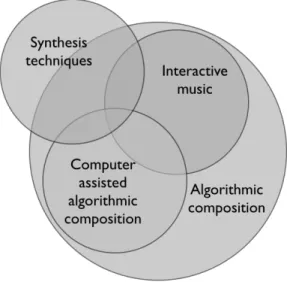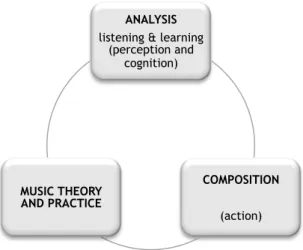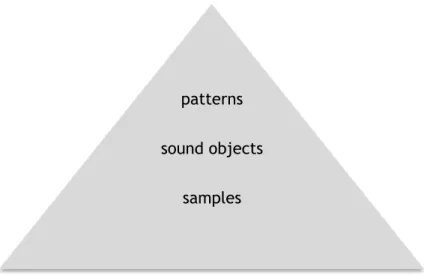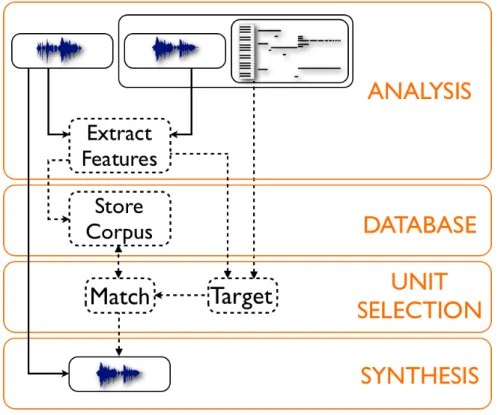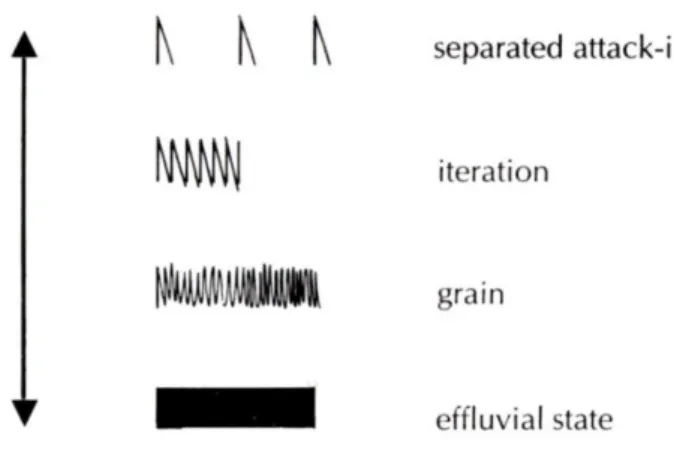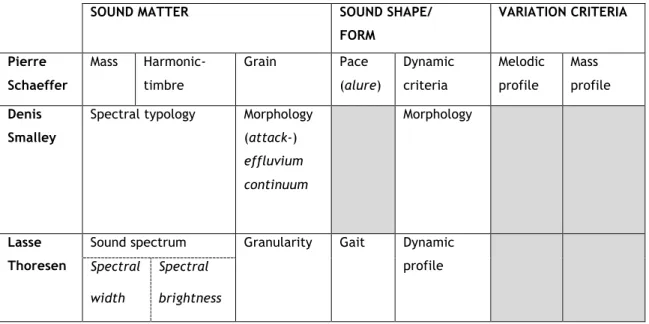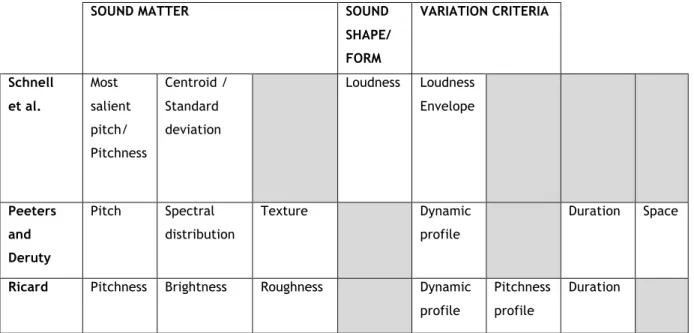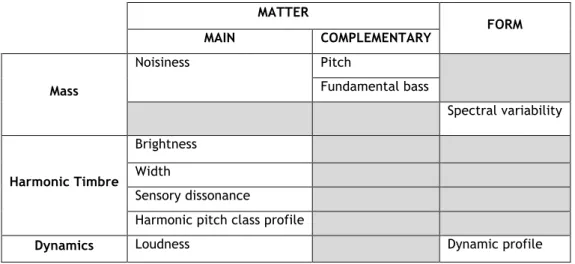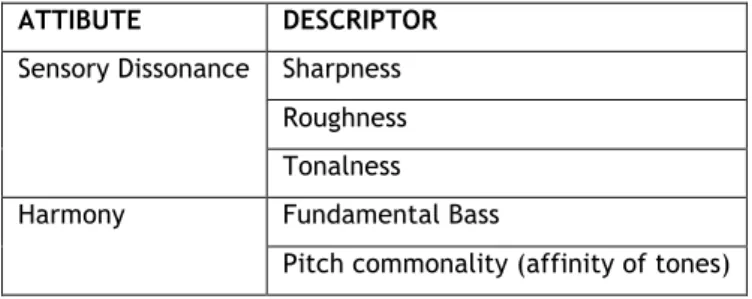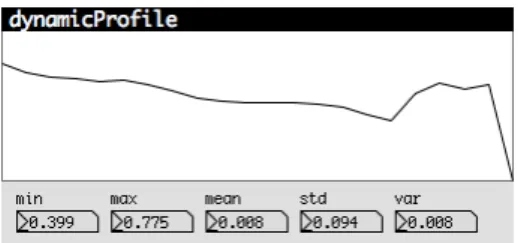COMPOSING MUSIC BY SELECTION
CONTENT-BASED ALGORITHMIC-ASSISTED AUDIO COMPOSITION
Gilberto Bernardes de Almeida
A dissertation submitted in partial fulfillment of the requirements for the degree of
Doctor of Philosophy
in Digital Media — Audiovisual and Interactive Content Creation
Dr. Carlos Guedes, advisor
Dr. Bruce Pennycook, co-advisor
Abstract
Musicians today have access to a vast array of multimedia content on personal and public databases, which consequently expands the possibilities for audio processing. Yet, composing with audio samples is still a very time-consuming task. A major reason for the disconnect between the state-of-the-art technology and current compositional practice is the lack of effective browsing methods for selecting, manipulating, and assembling samples for a particular application context.
My dissertation addresses the aforementioned mismatch by proposing an analysis-synthesis framework for assisting musicians in the daunting tasks of selecting and assembling audio signals, namely by incorporating algorithmic music strategies in the processing chain. I address problems raised by the implementation of audio signals in algorithmic composition by creating higher-level descriptions of sound objects, which drastically reduces their audio data representation and yet provides meaningful and highly flexible information. The proposed strategies for audio stream segmentation and
description rely on musicological theories, psychoacoustic dissonant models, and content-based audio processing techniques. Using these frameworks, I finally present algorithmic strategies for style imitation and genuine composition that recombine collections of annotated sound objects for a variety of musical contexts from installations to concert
music.
EarGram, the proof-of-concept software I developed as a result of this study,
integrates the proposed analysis-synthesis framework in a concatenative sound synthesis system. I also critically analyze some common issues in concatenative sound synthesis and propose the following three solutions that increase user flexibility and control, in
particular for creative purposes: (1) meaningful visualizations of the corpus in relation to specific sound typologies; (2) prioritization strategies and/or weights in the unit selection adapted to particular application contexts; and (3) minimization of concatenation
discontinuities between audio units by audio processing techniques.
In sum, this dissertation proposes a description scheme for representing sound objects that offers relevant information for the sound-based composer as well as suitable
descriptions for automatically modeling the temporal evolution of musical structure. In addition, the sound objects’ descriptions are highly flexible and allow the manipulation of audio signals in known computer-aided algorithmic composition strategies linked to
symbolic music representations. Ultimately, earGram helps musicians to easily manipulate audio signals in creative contexts—particularly by assisting in and automating a sound mosaic, which allows greater focus on the creative aspects of music making.
Keywords: algorithmic composition, music analysis, recombination, audio synthesis, concatenative sound synthesis.
Resumo
Atualmente os músicos têm acesso a um vasta gama de conteúdo multimédia em bases de dados pessoais e públicas que, consequentemente, expande as possibilidades para o processamento de áudio. No entanto, compor com amostras de áudio é ainda uma tarefa bastante morosa. A razão fundamental para a discrepância entre o estado-da-arte em tecnologia e a prática atual da composição é a falta de métodos de pesquisa eficazes para selecionar, manipular e montar amostras de áudio num contexto de aplicação específico.
A minha tese aborda a divergência anteriormente referida ao propor um sistema de análise e síntese para assistir o compositor nas exigentes tarefas de seleção e montagem de sinais de áudio, nomeadamente por incorporar estratégias de música algorítmica na cadeia de processamento. Eu abordo problemas que resultam da adopção de sinais de áudio na composição algorítmica através da criação de descrições de objetos sonoros de um nível mais alto que a sua codificação digital. Desta forma, reduz-se drasticamente a sua representação de áudio e providencia-se, no entanto, informações relevantes e altamente flexíveis. As estratégias propostas para a segmentação de áudio em objetos sonoros e a sua consequente descrição baseiam-se em teorias musicológicas, em modelos psicoacústicos de dissonância e em técnicas de processamento baseadas no conteúdo de sinais de áudio. Finalmente, apoiando-me em descrições de áudio, apresento estratégias algorítmicas para imitação de estilo musical e composição genuína que recombinam
coleções de objetos sonoros previamente anotados, e que se adaptam a uma série de contextos musicais desde instalações até música de concerto.
EarGram, o software que implementa o modelo que desenvolvi e que valida os
conceitos apresentados, integra o sistema proposto para análise e síntese num algoritmo de síntese concatenativa de som. Aqui, também analiso criticamente algumas questões pertinentes e conhecidas da síntese sonora concatenativa e propus as três soluções seguintes, as quais aumentam a flexibilidade de controlo do utilizador em contextos criativos: (1) visualizações representativas do corpus em relação a tipologias de som específicas; (2) estratégias de priorização e/ou factores de ponderação na seleção de unidades adaptados a contextos de aplicação específicos; (3) minimização das
descontinuidades resultantes da concatenação de unidades de áudio através de técnicas de processamento de áudio.
Em suma, esta tese propõe um esquema de descritores para representar objetos sonoros, que oferece informação relevante ao compositor de música baseada em som, assim como descrições apropriadas para a criação automática de modelos da evolução temporal da estrutura musical. O esquema analítico desenvolvido demonstra também uma grande flexibilidade e permite a manipulação de sinais de áudio em estratégias de
composição algorítmica assistida por computador altamente ligadas a representações musicais simbólicas. Em última analise, earGram auxilia os músicos na manipulação de sinais de áudio em contextos criativos—particularmente por assistir e automatizar o processo de montagem de mosaicos sonoros, permitindo-lhes um maior foco nos aspectos criativos da composição musical.
Palavras-chave: composição algorítmica, análise musical, recombinação, síntese de áudio, síntese concatenative de som.
Acknowledgments
It goes without saying that this dissertation is a collaborative work.
My initial words of gratitude go to my supervisors: Carlos Guedes and Bruce Pennycook, whose orientation, endless revisions, criticism, and support were seminal for completing this dissertation. I am deeply indebted to them for their rigor, patience, and
encouragement that allowed me to foresee ways to connect computational research to the world of contemporary music. I must also thank both my supervisors for their outstanding hospitality during my visits to New York University Abu Dhabi and University of Texas at Austin.
I want to acknowledge my colleagues and friends at FEUP: George Sioros, Rui Dias, Filipe Lopes, Rui Penha, Gustavo Costa e Rodrigo Carvalho for their continuous support, endless comments, and corrections of several stages of this document.
I would like to express my gratitude to the composers Nuno Peixoto, Rui Dias, and Ricardo Ribeiro, which showed interest and took the time to learn the software I
developed—earGram—in order to use it in their compositions. Their comments, questions, and suggestions were quite useful for improving the usability of the system.
I would like to thank Jessica Pabón, Steven Snowden, and June Snowden for their English corrections on the use of terms and grammar.
their more or less direct help in some components of earGram.
I would like to thank Daniela Coimbra for her exemplary modesty, willingness, patient help, and never ending generosity, which provided me the necessary mental force and courage to withstand deadline pressures.
I must also thank David Silva for his kindness and total availability to help me with the formatting and editing of the document.
I must acknowledge Fabien Gouyon for the heavy task of proofreading some chapters of the manuscript and his many helpful remarks.
I had the honor of being supported by a research grant from Fundação para a Ciência e Tecnologia (grant SFRH / BD / 46205 / 2008), without which it would be almost impossible for me to complete this doctoral program.
I also have the privilege of having an excellent group of friends that not only provided me great support in several stages of the research, but also kept an eye on me in order to not lose the motivation to be on stage. During the research period, I would like to
highlight some really important artists/friends with whom I had the pleasure to share the stage: Henk van Twillert, Hugo Marinheiro, Fernando Ramos, Isabel Anjo, and Cláudia Marisa.
I would like to thank my sister Marisa Bernardes de Almeida for her support and endless explanations of mathematical concepts.
My greatest gratitude goes to my parents: Joaquim da Silva Almeida and Maria Rosa Moreira Bernardes, for their long-term journey of love and sacrifice for me.
Table of Contents
Abstract Resumo Acknowledgments Table of Contents List of Figures List of Tables List of Abbreviations List of Sound Examples Contents of the CD-ROM Notes on TerminologyCHAPTER 1 – Introduction
1.1 - Motivation 1.2 – Approach
1.3 - Concatenative Sound Synthesis 1.3.1 - Technical Overview
1.3.1.1 - Analysis 1.3.1.2 - Database 1.3.1.3 – Unit Selection 1.3.1.4 – Synthesis 1.4 - Time Scales of Music
iii v vii ix xiii xvi xvii xix xxii xxx 1 4 6 10 11 13 13 14 15 15
1.5 - Outline of the Dissertation
PART I - ANALYSIS
2 - Sound Morphologies: From Pierre Schaeffer and Beyond 2.1 - Describing Sound
2.1.1 - A Western Musicology Viewpoint: From Note to Noise 2.2 – A Schaefferian Approach to Sound Based Theory
2.2.1 - Program of Music Research
2.2.2 - Morphological Criteria of Musical Perception 2.3 - After Schaeffer
2.3.1 - Denis Smalley’s Spectromorphology
2.3.2 - Lasse Thoresen and the Aural Sonology Project 2.4 – Critical Review and Summary
3 - Computational Segmentation and Description of Sound Objects 3.1 – Introduction
3.2 – Audio Descriptors
3.2.1 - Audio Description Schemes Inspired in Schaeffer’s Typo-Morphology
3.3 - Identifying Sound Objects Computationally 3.3.1 - Onset Detection
3.3.2 - Audio Beat Tracking
3.4 - A Musician-Friendly Audio Description Scheme 3.4.1 - Criteria of Mass
3.4.1.1 - Noisiness 3.4.1.2 - Pitch
3.4.1.3 - Fundamental Bass 3.4.1.4 - Spectral Variability 3.4.2 - Criteria of Harmonic Timbre
3.4.2.1 - Brightness 3.4.2.2 - Width
3.4.2.3 - Sensory Dissonance
3.4.2.4 - Harmonic Pitch Class Profile 3.4.3 - Criteria of Dynamics 3.4.3.1 - Loudness 17 19 20 21 22 24 26 27 30 30 33 36 40 40 41 43 45 46 48 49 53 53 55 56 57 57 60 61 62 63 63 64
3.4.3.2 - Dynamic Profile 3.5 - Summary
4 – Musical Patterns
4.1 - Probabilistic Models of Musical Structure 4.1.1 - Modeling Elements of Musical Structure
4.1.2 - Establishing Musical Progressions Based on Pitch Commonality 4.1.3 - Vertical Aggregates of Sound Objects Based on Sensory
Dissonance 4.2 - Audio Similarity 4.3 - Clustering 4.3.1 - K-means 4.3.2 - Quality-Threshold Clustering 4.3.3 - Density-Based Clustering 4.4 - Visualizations 4.4.1 - Sound-Space
4.4.1.1 - Two-Dimensional Visualizations of the Corpus Using Binary Sets of Descriptors
4.4.1.2 - Multidimensional Reduction of the Descriptor Space 4.4.2 - Self-Similarity Matrix
4.5 - Mid-Level Description of the Corpus 4.5.1 - Meter Induction
4.5.2 - Key Induction 4.6 – Part I Conclusion
PART II - COMPOSITION
5 - Organizing Sound
5.1 - From Sound to Music: Technical and Conceptual Considerations 5.1.1 - Sampling
5.1.2 - Micromontage 5.1.3 - Granular Synthesis
5.1.4 - Musical Applications of Concatenative Sound Synthesis 5.1.5 – Sound Structure as a Foundation for Compositional Systems 5.1.6 - Music as a Process
5.1.7 - Appropriation as a Musical Concept
64 65 67 68 69 71 72 74 78 79 80 81 82 83 84 86 88 90 90 92 95 97 99 100 100 102 103 104 108 110 112
5.2 - Design Strategies for Musical Composition 5.3 - Algorithmic Composition
5.3.1 – Algorithmic Composition Approaches
5.4 - Computational Life Cycle of Music: An Analysis-Synthesis Approach
6 - Content-Based Algorithmic-Assisted Audio Composition 6.1 - Composing a Corpus of Sound Units
6.1.1 - Planning the Macrostructure
6.2 – Micro-Time Sonic Design: SpaceMap and SoundscapeMap 6.2.1 - SpaceMap
6.2.2 - Playing with a Live Input Audio Signal 6.2.3 - SoundscapeMap
6.3 - Knowledge Engineering: ShuffMeter
6.4 - Empirical Induction and Knowledge Engineering: InfiniteMode 6.4.1 - StructSeq
6.4.2 - ChordSeq 6.5 - Synthesis
6.6 - Early Experiments and Applications of EarGram in Musical Composition
7 - Conclusion 7.1 - Summary 7.2 - Original Contribution 7.3 - Future Work Bibliography Appendices
Appendix A - Comparison of Concatenative Sound Synthesis Implementations, Inspired by Schwarz (2006b) and Sturm (2006b)
Appendix B - Related Publications
Appendix C- Chronological List of Work Created With EarGram
116 119 120 122 125 126 129 131 132 136 136 140 144 144 147 148 151 157 158 160 165 167 195 195 198 200
List of Figures
1.1 - Overlapping fields addressed by my research, inspired by Ariza (2005).
1.2 - Basic building blocks of the musical life cycle computationally modeled in this dissertation.
1.3 - Hierarchical organization of the musical time scales considered in the analytical module.
1.4 - Algorithmic scheme for CSS.
2.1 – Smalley’s (1986) morphological profiles of sound objects.
2.2 – Smalley’s (1986) attack-effluvium continuum.
3.1 - Dynamic profile of a sound object and the values extracted from the profile.
4.1 – Example of a matrix that exposes the sensory dissonance between all pair of sound objects in the corpus.
4.2 – EarGram’s parallels coordinates visualization of a corpus comprising a single audio track—4 by Aphex Twin.
5 7 8 12 32 33 65 73 77
4.3 - Visual representation of a corpus of audio units comprising a single audio source—4 by Aphex Twin—in a 2D-plot whose axes were assigned to the following descriptors: noisiness (x-axis) and spectral variability (y-axis). The units’ color is defined by sensory dissonance, loudness, and duration, by assigning each descriptor to the values of R, G, and B, respectively, and using an additive color model.
4.4 - Mapping of an eight-dimensional point to two dimensions. Axes are named as Cx, each dimension of the point as djx, and P is the final point position (Kandogan, 2000).
4.5 - Visualizations of a corpus comprising a single audio track—4 by Aphex Twin—by a self-similarity matrix (left image) and a related visualization whose color of each cell results from two found clusters in the corpus (rightmost image). The middle image is a detail of the self-similarity matrix, which exposes with detail the color of each cell.
4.6 - The Krumhansl and Kessler key profiles for C major and A minor keys (Krumhansl, 1990).
5.1 - Relationship between the components of the analysis and composition modules of the framework.
6.1 - Three sub-spaces of the corpus defined on top of self-similarity matrix visualization.
6.2 - Software interface that allows a user to constrain the corpus in earGram.
6.3 - Software interface that allows a user to specify the automation of several parameters of the playing mode spaceMap in earGram through the use of tendency masks.
6.4 - Software interface of the playing mode soundscapeMap.
6.5 - Comparison between a corpus representation in a 2D-plot before (left image) and after (right image) space optimization.
83 88 89 93 123 130 130 135 137 138
6.6 - Probability distribution given by Clarence Barlow’s indispensability formula for the 16 pulses comprising the 16th note level of 4/4, which is defined as the product of prime factors 2x2x2x2.
6.7 - Software interface of the playing mode shuffMeter.
6.8 - Indispensability weights’ distribution for four pulses of a 4/4 bar given by Clarence Barlow’s (1987) formula. The three graphs correspond to the clusters depicted in Figure 6.7 and each configuration was scaled and conveys a percentage of variance according to their position on the navigable map.
6.9 – Software interface of the playing mode infiniteMode.
6.10 - Representation of the amplitude envelope of synthesized units with slight overlap. The yellow box corresponds to the actual duration of the unit, and the red box to the extension added to the unit in order to create the overlapping period.
6.11 - Spectrogram representations of the same concatenated output without (top image) and with (bottom image) spectral filtering
(expansion-compression).
6.12 – Visualization of the corpus that supported the creation of the raw material for the installation Urban Sonic Impression.
141 142 143 146 149 151 154
List of Tables
2.1 - Comparison between criteria of music perception of three representative sound-based theories by Pierre Schaeffer, Denis Smalley, and Lasse
Thoresen.
3.1 - Comparison between computational schemes for the description of perceptual attributes of sound inspired by Schaeffer’s typo-morphology.
3.2 - Description scheme used to characterize the audio content of sound objects in earGram.
3.3 - Perceptual attributes of musical dissonance according to Terhardt.
4.1 - Flowchart of the algorithm that reduces the Bark spectrum representation to a single value. 38 45 52 59 70
List of Abbreviations
List of de abbreviations (ordered alphabetically).
ASP Aural Sonology Project
CAAC Computer aided algorithmic Composition CSS Concatenative sound synthesis
DBSCAN Density-based clustering
GRM Groupe des Recherches Musicales HPCP Harmonic pitch class profile
IRCAM Institut de Recherche et Coordination Acoustique/Musique
K-S Krumhansl-Schmuckler
K-K Krumhansl-Kesseler
MDS Multidimensional scaling MIR Music information retrieval
MIDI Musical Instruments Digital Interface
MPEG Motion Pictures Expert Group
PROGREMU Program of music research PSOLA Pitch synchronous overlap add QT-clustering Quality-threshold clustering
TOM Traité des Objects Musicaux (Treaty of Musical Objects) TTS Text-to-speech
List of Sound Examples
1 - Three musical phrases synthesized in spaceMap by navigating the visualization of the corpus with the same trajectory and utilizing the following pairs of audio features: (1) fundamental bass and spectral variability; (2) width and sensory dissonance; and (3) noisiness and loudness, respectively.
2 - Sound generated in soundscapeMap by recombining audio units from a corpus resultant from the onset segmentation of a tropical forest recording. The target was defined by navigating the soundscapeMap’s interface, which largely corresponds to a trajectory that goes from sparser and smoother (lower-left corner of the interface) to denser and sharper (top-right corner of the interface).
3 - Sound generated in soundscapeMap by recombining audio units from a corpus resultant from the onset segmentation of a storm recording. The target was defined by navigating the soundscapeMap’s interface, which largely
corresponds to a trajectory that goes from sparser and smoother (lower-left corner of the interface) to denser and sharper (top-right corner of the interface).
4 - Three phrases generated in sounscapeMap that synthesize targets that change gradually from the most consonant to the most dissonant—all remaining parameters, density-sparsity and smoothness-sharpness, remain unchanged.
5 - Sound example generated in shuffMeter. It exposes the utilization of different instrumental sound clusters extracted from a collection of both drum and bass samples.
6 – Sound generated by recombining and layering different sound clusters extracted from Bob Marley’s Don’t Worry, Be Happy, sung by Bobby McFerrin, utilizing a predefined meter of 4/4.
7 – Sound generated by recombining and layering different sound clusters extracted from Bob Marley’s Don’t Worry, Be Happy, sung by Bobby McFerrin, utilizing a predefined meter of 3/4.
8 - Sound generated in infiniteMode’s structSeq that recombines and extends the initial 28 seconds of Jean-Baptiste Lully’s Les Folies d’Espagne (1672, LWV 48).
9 - Sound generated in infiniteMode’s chordSeq that recombines and extends the initial 28 seconds of Jean-Baptiste Lully’s Les Folies d’Espagne (1672, LWV 48).
10 - Random recombination of audio segments extracted from Jean-Baptiste Lully’s Les Folies d’Espagne (1672, LWV 48), which have also been used in sound
examples 8 and 9.
11 - Electronic composition Schizophonics (2012) by Rui Dias.
12 – Scale produced by the organization of sound samples according to the brightness of the audio units from the Porto Sonoro sound bank utilized in
Urban Sonic Impression (2013).
13 – Scale produced by the organization of sound samples according to the brightness of the audio units from the Porto Sonoro sound bank utilized in
Urban Sonic Impression (2013).
14 - Excerpt of the sound installation Urban Sonic Impression (2013) by Rui Dias and Gilberto Bernardes.
15 - Live recording of Nuno Peixoto’s song Your Feet (2012), performed by Rita Redshoes (voice) and Nuno Aroso (percussion).
16 - EarGram’s “sonic transcription” of the composition Your Feet (2012) by Nuno Peixoto synthesized with piano and clarinet sounds (sound example 19).
17 - EarGram’s “sonic transcription” of the composition Your Feet (2012) by Nuno Peixoto synthesized with piano and clarinet sounds (sound example 19).
18 - EarGram’s “sonic transcription” of the composition Your Feet (2012) by Nuno Peixoto synthesized with piano and clarinet sounds (sound example 19).
19 - Synthesized MIDI version of Nuno Peixoto’s song Your Feet (2012) with piano and clarinet.
3.
Contents of the CD-ROM
software ReadMeFirst.txt earGramv.0.18.pd absOverview.pd COPYING.txt dependencies abs 2d.tabread-help.pd 2d.tabread.pd 2d.tabwrite-help.pd 2d.tabwrite.pd 2dPlot-help.pd 2dPlot.pd average-help.pd average.pd bagFifo-help.pd bagFifo.pd barGraph-help.pd barGraph.pd beatInduction-help.pd beatInduction.pd bus.input.pd bus.output.pdbus.pd bus0.output.pd collection.pd colorGrid-help.pd colorGrid.pd correlate-help.pd correlate.pd covariance-help.pd covariance.pd data K-K-profiles.txt psi-functions.txt Temperley-profiles.txt vera.ttf dbscan-help.pd dbscan.pd depot-help.pd depot.pd featureDisplay.pd first-help.pd first.pd grain.pd hpcp-help.pd hpcp.pd indispenser-help.pd indispenser.pd k-means-help.pd k-means.pd keyInduction-help.pd keyInduction.pd list-bounds-help.pd list-bounds.pd list-combine-help.pd list-combine.pd list-datasort-help.pd list-datasort.pd
list-euclid-help.pd list-euclid.pd list-maximum-help.pd list-maximum.pd list-minimum-help.pd list-minimum.pd list-permut-help.pd list-permute-help.pd list-permute.pd list-sliding-help.pd list-sliding.pd list-stats-help.pd list-stats.pd markovRetrieve-help.pd markovRetrieve.pd markovStore-help.pd markovStore.pd menu.window.pd meterInduction-help.pd meterInduction.pd minmax-help.pd minmax.pd mtx-stats-help.pd mtx-stats.pd mtxOptimization-help.pd mtxOptimization.pd num2rgb-help.pd num2rgb.pd onsetDetect-help.pd onsetDetect.pd parallelCoordinatesDef.pd pitchCommonality-help.pd pitchCommonality.pd pitchSalience-help.pd pitchSalience.pd pitchShift~-help.pd
pitchShift~.pd qt-clustering-help.pd qt-clustering.pd quantize-help.pd quantize.pd randomWalk-help.pd randomWalk.pd rgb2pd-help.pd rgb2pd.pd rgbAverage.pd roughness-help.pd roughness.pd rSlider-help.pd rslider.pd rt.buttons.pd runningAverage-help.pd runningAverage.pd runningCollAverage.pd runningCovariance-help.pd runningCovariance.pd runningStats-help.pd runningStats.pd scale-help.pd scale.pd similMtxDist-help.pd similMtxDist.pd smooth_triple.pd spaceMapDefH.pd spaceMapDefV.pd starCoordinates-help.pd starCoordinates.pd starPlot-help.pd starPlot.pd stats-help.pd stats.pd store.param.f.pd
store.param.l.pd store.param.s.pd TIE.6.pd triggerBox-help.pd triggerBox.pd vead~-help.pd vead~.pd waveformDisplay-help.pd waveformDisplay.pd wavestretch~-help.pd wavestretch~.pd externals soundHack +spectralcompand-help.pd +spectralcompand~.pd_darwin tID bark-help.pd bark.pd_darwin bark~-help.pd bark~.pd_darwin barkSpec-help.pd barkSpec.pd_darwin nearestPoint-help.pd nearestPoint.pd_darwin specCentroid-help.pd specCentroid.pd_darwin specCentroid~-help.pd specCentroid~.pd_darwin specFlatness-help.pd specFlatness.pd_darwin specFlatness~-help.pd specFlatness~.pd_darwin specFlux-help.pd specFlux.pd_darwin specFlux~-help.pd specFlux~.pd_darwin
specIrregularity-help.pd specIrregularity.pd_darwin specIrregularity~-help.pd specIrregularity~.pd_darwin specKurtosis-help.pd specKurtosis.pd_darwin specKurtosis~-help.pd specKurtosis~.pd_darwin specSpread-help.pd specSpread.pd_darwin specSpread~-help.pd specSpread~.pd_darwin tabletool-help.pd tabletool.pd_darwin fx bCrush~-help.pd bCrush~.pd Chorus~-help.pd Chorus~.pd Compand~-help.pd Compand~.pd DelayFb~-help.pd DelayFb~.pd EQ~-help.pd EQ~.pd Flanger~-help.pd Flanger~.pd Freeze~-help.pd Freeze~.pd Morph~-help.pd Morph~.pd Revm2s~-help.pd Revm2s~.pd Revs2s~-help.pd Revs2s~.pd
projectExamples ReadMeFirst.txt project1_chordProgressionC7.csa project2_lullyFolies.csa project3_rainforest.csa project4_rissetMutations.csa project5_techno.csa audio chordProgressionC7.wav lullyFolies.wav rainforest.wav rissetMutations.wav techno drumLoop1.wav drumLoop2.wav drumLoop3.wav synthLoop1.wav synthLoop2.wav soundExamples ReadMeFirst.txt soundExample1.mp3 soundExample2.mp3 soundExample3.mp3 soundExample4.mp3 soundExample5.mp3 soundExample6.mp3 soundExample7.mp3 soundExample8.mp3 soundExample9.mp3 soundExample10.mp3 soundExample11.mp3 soundExample12.mp3 soundExample13.mp3 soundExample14.mp3 soundExample15.mp3 soundExample16.mp3
soundExample17.mp3 soundExample18.mp3 soundExample19.mp3
Notes on Terminology
In order to clarify and avoid terminological misconceptions, I will define and constrict the use of three concepts, or pairs of concepts, which will be extensively utilized in this dissertation: (1) computer-aided algorithmic composition; (2) concatenative sound synthesis; and (3) sound object/audio unit.
Computer-aided algorithmic composition is a term coined by Christopher Ariza (2005) that combines two labels—computer-aided composition and generative music—and refers to algorithmic composition strategies mediated by a computer. While computer-aided composition emphasizes the use of a computer in composition, generative algorithms assign the nature of the compositional process to algorithmic strategies. I utilize the term CAAC to pinpoint my focus on algorithmic music strategies that are generally intractable without a high-speed digital computer given the central position of computer usage in the field of algorithmic composition.
Concatenative sound synthesis is a sample-based synthesis technique that I adopted in this dissertation as the technical basis of a devised model. In literature, it is common to find descriptions such as musical mosaicing, musaicing, concatenative sound synthesis, and corpus-based concatenative sound synthesis that explain overlapping (or sometimes
identical) approaches—most enhance idiosyncratic aspects of a particular approach to the technique, yet all adopt a common framework. I use concatenative sound synthesis to address the technique in its broad range, avoiding specifying particularities. For a comprehensive definition of the technique please refer to section 1.3.
Sound object denotes a basic unit of musical structure analogous to the concept of note in traditional Western music approaches (Schaeffer, 1966) and audio unit refers to an audio segment with any duration and characteristics manipulated in a concatenative sound synthesis system. Despite their differences, for the purpose of this dissertation, I use the terms sound unit and sound object interchangeably, because I limited the use of audio units to sound objects. While sound objects relate to the conceptual basis of my study, which is greatly attached to musicological literature, audio units are used whenever I focus on a more technical consideration of concatenative sound synthesis, which may encompass audio segments of different structural natures than sound objects.
Chapter 1
Introduction
Music and technology have been closely linked since ancient times. It is even unthinkable to speak and discuss music and its history without considering the
technological developments associated with it. Musical instruments like the piano and violin, for instance, are a remarkable result of the collaboration between music and technology. Musical instruments not only constitute major pieces of technological
mastery, but are also seminal for the development of musical expression. As Curtis Roads notes, “the evolution of musical expression intertwines with the development of musical instruments” (Roads, 2001, p. 2).
Given the close link between music and technology, it does not seem surprising that the rapid expansion of electronic technology in the late 19th century had a tremendous impact on musical practice a few decades later. In the beginning of the 20th century, the ability to record, amplify, reproduce, and generate sound by electronic means
tremendously affected the way we perceive, interpret, and compose music. In the late 1970s, the advent of affordable personal computers offered another avenue for the production of music by electronic means. Computers have become a fundamental tool.
However the music community was, and is still to a certain extent, reluctant to use computers as “creative machines” under the assumption that they are not capable of producing relevant artistic results.
The early days of computer music systems relied almost exclusively in symbolic music representations, in particular the Musical Instrument Digital Interface (MIDI) standard. Symbolic music representations encode physical actions rather than an acoustic reality (Rowe, 2001), and model closely the behavior of a piano keyboard, as well as traditional concepts of music notation (Rowe, 2009). Despite its clean, robust, and discrete
representation of musical events, symbolic music codes have many drawbacks. For instance, the MIDI standard, one of the most common symbolic music codes, was recognized since its inception to be slow and very limited in its scope of representation (Moore, 1988).1
Audio signals, and in particular digital audio signals, are the most common music representations used today. Contrary to symbolic representations, audio signals encode the music experience, or, in other words, the physical expression or performance. Even if it is a very precise, flexible, and rich representation of the auditory experience and opens up possibilities others than the MIDI or any other symbolic music representation, audio signals also pose crucial problems. Audio signals’ low-level representation reclaim the use of algorithmic strategies, importantly including the field of sound and music computing and music information retrieval (MIR), to extract information from the content of the signal.
The field of research concerned with the extraction of information from audio signals is commonly addressed as content-based audio processing, which gained increasing attention in recent years given the large expansion of multimedia content over personal and public databases. Due to the considerable increase of audiovisual contents, it became crucial to develop algorithms for browsing, mining, and retrieving these huge collections
of multimedia data (Grachten et al., 2009). A substantial body of knowledge has been presented over the last few years, which offers various solutions to help users deal with audio signals in the era of digital mass media production.
The widespread availability of multimedia databases not only affected how users access, search, and retrieve audio, but also enacted critical transformations in how creative industries produce, distribute, and promote music. Research on multimedia information retrieval has also been gradually incorporated in creative work, despite the gap between state-of-the-art research in multimedia information retrieval and usability.
From a creative standpoint, processing audio data is still a very elaborate and time-consuming task. Currently, to create electronic music one usually needs to use software that emulates old analog-tape production means (e.g. audio and MIDI sequencers). These software workstations demand a considerable amount of time to select, segment, and assemble a collection of samples. Despite the large and ever-increasing amount of audio databases, sound-based composers must manage tremendous difficulties in order to actually retrieve the material made available in the databases. One of the most evident and prominent barriers for retrieving audio samples is the lack of appropriate and
universal labels for sound description adapted to particular application contexts and user preferences.
In this study, I aim to improve music analysis and composition by devising an analytical framework that describes the audio content of sound objects by minimal, yet meaningful, information for users with a traditional musical education background. Consequently, the audio descriptions will be tested as possible representations of sound objects in computer-aided algorithmic composition strategies (CAAC) greatly attached to symbolic music representations. The ultimate goal is to devise CAAC strategies that deal almost exclusively with audio signals in order to ease the manipulation of audio samples in creative contexts. In addition to the reformulation of known CAAC to process audio
signals, I study new strategies for composing based on the idiosyncrasies of computer music and the description scheme.
The framework proposed will be integrated into an algorithm for concatenative sound synthesis (CSS) and implemented as software (earGram) to test and verify several
strategies to analyze and reassemble audio (a detailed description of CSS can be found in section 1.3).
1.1 - Motivation
After completing a Master of Music degree at the Conservatory of Amsterdam, which opened possibilities for aesthetic experimentation with interactive music systems, I had the chance to enroll in a new Doctoral program between two renowned Portuguese Universities—University of Porto and the New University of Lisbon—under the auspices of the University of Texas at Austin.
At first, I was integrated into a project coordinated by my supervisors: “Gestural controller-driven, adaptive, and dynamic music composition systems” (project reference UTAustin/CD/0052/2008). My involvement with the project gave me a solid theoretical and applied knowledge of generative music, which became seminal for fulfilling the objective of this dissertation. By the time I enrolled in the PhD program, I was mainly concerned with the compositional possibilities of using audio signals as the primary music representation in interactive music systems, in particular the use of large collections of audio samples as raw material for musical processing. One of the major reasons motivating my research was the poor sound and expressive qualities of MIDI synthesizers. A major influence is the work of Tristan Jehan, namely his PhD dissertation Creating Music by
Listening (Jehan, 2005), and soon it became clear that I would work at the intersection of
many fields including sound synthesis (namely CSS), algorithmic composition, CAAC, and interactive music (see Figure 1.1).
The ultimate goal of this dissertation is twofold: (1) to reshape the compositional experience of working with audio samples, and (2) to devise an intuitive and intelligible guided search and navigation through large collections of sound-objects oriented towards music composition.
Figure 1.1 - Overlapping fields addressed by my research, inspired by Ariza (2005).
The model I propose aims at reformulating the audio-content description of CSS system audio units through a musical theory and practice standpoint, and targets an audience more familiarized with music theory than with music technology. While my intent is to minimize the usage of computer science terminology, some is unavoidable—particularly concepts related to music information retrieval.2 In addition, earGram will allow the fast exploration of compositional practices by incorporating several CAAC techniques related to symbolic music representation as unit selection strategies in a CSS system, thus proposing new approaches to explore creatively large collections of audio segments.
2 Music information retrieval is “a multidisciplinary research endeavor that strives to develop innovative content-based searching schemes, novel interfaces, and evolving networked delivery mechanisms in an effort to make the world’s vast store of music accessible to all” (Downie, 2004, p. 12).
1.2 - Approach
In this dissertation I claim the following hypothesis:
Sharing the same constitutive elements manipulated through reciprocal operations, morphological and structural analyses of musical audio signals convey a suitable representation for computer-aided algorithmic composition.
In other words, I suggest that analysis3 and composition share the same structural elements and can thus be (computationally) seen as complementary operations of a close musical activity cycle. While analysis fragments the sound continuum into constituent elements according to a bottom-up approach in order to reveal and abstract
representations of the various hierarchical layers of musical structure, composition elaborates these same elements in an opposite fashion by organizing musical elements from the macrostructure down to the lowest level of musical structure (top-down approach).
The interaction between analysis and composition cannot be discussed without considering music theory. Music analysis and composition not only depart from music theory, but also the constant dialogue between the two fields contributes to music theory with new principles and compositional systems (see Figure 1.2 for an abstract
representation the interaction between several agents of the cycle).
Any analysis-synthesis computational approach must describe musical structure. Music theorists have recognized and identified in the temporal span of the music continuum several hierarchical levels (Roads, 2001). The composer’s task is undoubtedly to elaborate
3 Analysis refers to the general process of separating something into its constituent elements and to a certain extent to the examination of the elements or structure of something, typically as a basis for discussion or interpretation. However, it does not imply music analysis, which focuses essentially on the interpretation and
the several levels of creating a sonic work. Analysis often examines a compositional impulse, while composition often elaborates an analytical impulse.
In order to pursue the aim of this dissertation, I intend to computationally model the music cycle present in Figure 1.2. Specifically, I aim to design a computational system that learns from given musical examples, and/or relies on music theory knowledge, in order to generate meaningful musical results with minimal user interference. The analysis agent encompasses two operations: listening (perception) and learning (cognition), while its complementary agent is composition (action). These two agents are in a constant and reciprocal dialogue with music theory, a repository of knowledge constantly populated with new knowledge generated by the two aforementioned agents.
Figure 1.2 - Basic building blocks of the musical life cycle computationally modeled in this dissertation.
My analysis of audio signal content aims at providing representations and revealing patterns of the musical surface higher than the sample temporal unit. In order to do so, I will devise a bottom-up or data-driven computational model for the automatic
segmentation and description of sound objects and musical patterns according to criteria of musical perception grounded in sound-based theories by Pierre Schaeffer (1966), Denis Smalley (1986, 1997, 1999), and Lasse Thoresen (2007a, 2007b). Alongside a critical
ANALYSIS
listening & learning (perception and cognition) COMPOSITION (action) MUSIC THEORY AND PRACTICE
discussion of the criteria of musical perception proposed in the cited theories, I will devise a set of descriptors for characterizing sound objects; the description scheme is adapted to the idiosyncrasies of a CSS system. Relying on the sound objects’ descriptions, I then identify and model higher structural levels of the audio data by grouping sound objects into recognizable patterns up to the macro-temporal level.
Outlined from a music theory and practice standpoint, my model is adapted for music analysis and composition. The outcome of the model intends to provide a rich
representation of the audio content in a compact and meaningful representation. However, it does not provide a successful answer to the ultimate goal of the analyst, which is to explain the organization of several events and to reveal how meaning derives from those organizations. Instead, the model provides information that can either allow a different view over the sound material or establish comparisons between vast amounts of material that are not traceable by human senses. A human interference is mandatory in order to determine the causal linkages between the sonic objects and to determine the relationships between patterns (if this level of syntax exists).
Figure 1.3 – Hierarchical organization of the music time scales considered in the analytical module.
patterns
sound objects samples
Segmenting the several layers in an audio continuum, along with the description of its constituent units (sound objects), not only provides a groundwork for the analyst, but also for the sound-based composer. In other words, the outcome of my analytical model is suitable for guiding the composition process by reciprocating the analytical operations (i.e. through a top-down or knowledge driven approach). The outcome of my analysis offers the composer a good representation of the audio source’s structure and allows a fast and intuitive reorganization of the segments from the macrostructure to the basic element of the musical surface (sound object).
One can compose the macrostructure in earGram by selecting sub-spaces of the corpus that can be assigned to a particular piece, performance, or even to different sections of a work. The process is manual, but guided by several visualizations that expose the
structural organization of the corpus, such as similarity matrices and 2D-plots. Some patterns of the audio source(s) structure may also be revealed through the use of clustering techniques in combination with the visualization strategies aforementioned.
The recombination of the sound segments in earGram is automatic and it is mostly done by adapting CAAC algorithms related to symbolic music representations to function as selection procedures in CSS. The CAAC strategies can be guided by music theory knowledge or models created during analysis from user-given examples.
As the name implies, CSS deals with the concatenation or juxtaposition of sound segments, that is, the horizontal dimension of musical structure (e.g. melody, metrical accents, dynamics and properties relating to timbre). However, it is also my intention to expand the CSS scope of action to handle the recombination of units in the vertical dimensions of musical structure (units’ simultaneity) as a cause of timbre creation and variance, control of the event density, and (psychoacoustic) dissonance.
Finally, in earGram I will explore the idea that all sonic parameters, such as brightness and sensory dissonance, can be as important as parameters like pitch and duration, which are commonly seen as primary elements of musical structure. I envision all criteria for
sound description as fundamental “building blocks” for compositional systems. This is not to say that every piece composed by these means must use equally all sonic parameters, but that all sonic parameters may be taken into careful consideration when designing a musical work and seen as primary elements of musical structure.
1.3 - Concatenative Sound Synthesis
CSS is “a new approach to creating musical streams by selecting and concatenating source segments from a large audio database using methods from music information retrieval” (Casey, 2009). Briefly, CSS uses a large “corpus” of segmented and descriptor-analyzed sounds snippets, called “units”, and a “unit selection” algorithm that finds the best matching units from the corpus to assemble a “target” phrase according to a similarity measure in the descriptor space.
The first CSS software appeared in 2000 (Schwarz, 2000; Zils & Pachet, 2001) and their technical basis strongly relied on concatenative text-to-speech (TTS) synthesis software—a technique presented in the late 1980s (Schwarz, 2004). CSS began to find its way into musical composition and performance beginning in 2004, in particular through the work of Bob Sturm (2004, 2006b) and Diemo Schwarz (Schwarz, Britton, Cahen, & Goepfer, 2007; this paper documents the first musical compositions and installations exclusively produced by CataRT, a real-time CSS software developed by Schwarz). Currently CSS is considered state-of-the-art in terms of sample-based techniques and content-based audio processing. The technique is at an interesting phase of development and attracts a broad audience of users, researchers, and developers from the scientific to the artistic community. CSS shows great potential for high-level instrument synthesis, resynthesis of audio, interactive explorations of large databases of audio samples, and procedural audio—especially in the context of interactive applications, such as video games. Despite its mature development at engineering and technological levels, CSS is rather undeveloped in terms of aesthetic
and utilitarian concerns. In addition, even though most research in CSS is oriented toward music, the technique lacks substantial contributions in terms of creative output.
In the next section, I will provide an overview of the modules that constitute a CSS system with regard to its technical implementation. Along with the description of the different modules, I will detail the signal data flow of the algorithm and the fundamental terminology associated with each operation. The following overview is restricted to the core components of a CSS and covers the majority of existing CSS software
implementations, but it does not target existing variants and subtleties. In addition, the present overview does not distinguish between online or offline approaches. Even if there are some minor differences between the two approaches, the general architecture is the same. Whenever appropriate, I will note the most prominent distinctions.
1.3.1 - Technical Overview
CSS systems commonly comprise four modules: (1) analysis, (2) database, (3) unit selection, and (4) synthesis (see Figure 1.4). Analysis is responsible for segmenting an audio source into short snippets of audio (named units) and describing their content by a set of features (e.g. pitch, loudness, instrument, etc.). The database is responsible for storing all data produced during analysis, which can be later accessed by all of the remaining system components at runtime. The unit selection algorithm is responsible for finding the best matching unit from the database to a target specification. Finally, synthesis converts the output of the unit selection module into audio format. The
following paragraphs examine each component of the system individually and point to the respective processing. In addition, the reader can refer to Appendix A for a broad
comparison of CSS software according to prominent features such as types of
segmentation, audio units’ representations, algorithms for unit selection, concatenation type, implementation code, and speed.
Figure 1.4 - Algorithmic scheme for CSS.
Before describing the algorithm I should clarify two CSS-related concepts and one procedure necessary for the proper functioning of a CSS system. The concepts are unit and corpus, and the procedure is the user-assigned data needed to feed the system. The first tem, unit, is the most basic element of the synthesis algorithm. The algorithm synthesizes new sounds by concatenating selected units that best match a particular target
specification. A unit has the same structural value in CSS as a musical note in traditional instrumental music, or even a grain in granular synthesis. Corpus refers to a collection of
units. Before any processing takes places, the user must feed a CSS system with audio data
that is subsequently segmented into units to form a corpus. This data will be addressed as audio source(s). The choice of the audio source(s) is crucial to the quality of the synthesis because it constitutes the raw material that is concatenated in the end of the processing chain to create new sounds.
1.3.1.1 – Analysis
The analysis module is responsible for two tasks: (1) to segment the audio source(s) into units, and (2) to provide feature vectors that describe the intrinsic characteristics of the units. During segmentation the audio source is divided into several units according to an algorithmic strategy. CSS makes use of different algorithms to segment an audio stream. The outputs are pointers that define the boundaries of each unit.
Analysis comprises a second task that is responsible for extracting relevant audio features from all units in the corpus. The extracted characteristics are further merged into feature vectors that represent the units in all subsequent operations of the system. The feature vectors can be seen as signatures of the units because they provide
meaningful and significantly smaller representations of its data. The feature vectors commonly address various characteristics of the units, which, consequently, define a multidimensional space in which the collection of units can be represented.
1.3.1.2 – Database
The database is responsible for storing the data handled and generated during analysis. It includes basic information concerning the units’ location in the audio source, along with their representative feature vectors. Several database architectures can be found in CSS software. Most often the database is drawn from scratch in the language in which the application is developed and uses a proprietary analysis data format. Very few
implementations adopt common architectures for managing data such as the Structured Query Language (SQL) or its derivatives (Schwarz, 2004; Schwarz, 2006a).
1.3.1.3 - Unit Selection
After creating the corpus, the system is ready to synthesize target phrases. This operation takes place in the two remaining modules of the algorithm, that is, the unit selection and synthesis. Before I detail the unit selection algorithm, I would like to note that it is important to understand the various possibilities of defining target phrases. The target is a representation of a musical phrase, commonly provided by the user, which must be presented to the algorithm as a collection of features in a similar way as the feature vectors created during analysis.
Most systems provide mechanisms for avoiding the user to specify targets as audio features. Instead, what the user commonly presents to the computer is either an audio signal or any other tangible music representation such as MIDI information. Consequently, the system must be able to convert the input representation into a collection of feature vectors. There are two major approaches to the task: (1) data driven and (2) rule-based methods. Data-driven strategies produce targets from the data by applying a set of analytical tools. An example is the transduction of an audio signal into proper feature vector representations. Rule-based approaches encapsulate knowledge to interpret provided information in a meaningful representation to the system. A typical example is the conversion of MIDI data into a string of audio features.
Unit selection encompasses an algorithm that is responsible for searching the corpus and selecting the best matching units according to a given target. In most cases, the unit selection algorithm relies on two conditions to find the best matching unit from the
corpus, according to the target specification: the (1) target cost and the (2) concatenation cost. The target cost, also known as local search, is computed by finding the units from the corpus that minimize the distance function to the target in the descriptor space. Different distance metrics are used in CSS, such as Euclidian distance (Hoskinson & Pai, 2001; Hackbarth et al., 2010), Manhattan distance (Brent, 2009), Mahalanobis distance
(Schwarz, 2005), and dot product (Hazel, 2001; Kobayashi, 2003). The concatenation cost, or global search, controls the quality of the units’ concatenation. The computation of such criteria may encompass several variables and can be defined by different means. The most common approach is the computation of descriptors’ discontinuities introduced by
adjacent units. Online systems take care of concatenation cost in a limited way. Most often, online systems consider characteristics of the previously selected unit to constrain the selection processes of the next unit (Schwarz, 2006a). This module outputs the units’ numbers or any other pointers that represent the selected units to be synthesized.
1.3.1.4 - Synthesis
Synthesis is the last stage of a CSS system. It is responsible for synthesizing the selected units provided by the unit selection module. The simplest approach to synthesis is to interpret the string of pointers provided by the previous module, find their position on the audio source, and play or render the respective units. The most recent CSS systems also allow the synthesis of overlapping units. This last possibility is quite similar to the playback engine of a granular synthesizer. Some systems also provide the possibility to apply audio effects at the end of the processing chain (Lazier & Cook, 2003; Schwarz et al., 2008).
1.4 - Time Scales of Music
The framework I am proposing deals extensively with the various hierarchical levels of music. In order to establish a set of unambiguous terms to address the various structural levels, I will adopt a taxonomy proposed by Roads (2001) to systematically define all possible time scales of music. Roads’ taxonomy presents a comprehensive list of nine music time scales, which cover the various layers of musical structure. The taxonomy
includes the following:
1. “Infinite” refers to a time span of infinite mathematical durations.
2. “Supra” refers to the temporal span beyond the duration of a composition. 3. “Macro” represents the overall architecture, or form, of a musical work. 4. “Meso” comprises the musical phrase formed by dividing the macro structure into smaller parts, or by grouping sound objects into constituent phrase structures of various sizes.
5. “Sound object” is the basic unit of musical structure analogous to the concept of note in traditional instrumental music, but encompassing all perceivable sonic matter.
6. “Micro” encompasses sound particles on a time scale that extends down to the threshold of auditory perception (measured in thousandths of a second or millisecond).
7. “Sample” is the smallest level of the digital representation of an analog audio signal commonly expressed by numerical amplitude values at a fixed time interval.
8. “Subsample” is an unperceivable time scale given its too short duration, and can be understood as the fluctuations that occur below the sample time scale.
9. “Infinitesimal” refers to a time span of infinitely brief mathematical durations.
The four most extreme time scales proposed by Roads—infinitesimal, subsample, infinite and supra, two micro and two macro time scales, respectively—define contextual music situations that are not relevant to the scope of this dissertation because one cannot directly manipulate them in a practical context. However, the reader should be familiar with the five remaining time scales—from sample to macro—because they will be extensively addressed throughout the dissertation.
all time scales. Even if these values offer a comprehensible suggestion of the duration of each scale of music, they may also provide erroneous information because in a concrete musical work all time scales are identified and definable based on their function, rather than their effective duration.
1.5 - Outline of the Dissertation
I have divided this dissertation into two large parts. Part I (chapters 2, 3, and 4) provides a review of musicological theories for sound description and then offers an
algorithmic description scheme for describing and modeling the content of audio signals at various hierarchical levels. Part II (chapters 5, 6, and 7) presents algorithmic strategies to automatically recombine segmented-analyzed audio units, then summarizes the original contribution of this study, and finally provides guidelines for future work.
Chapter 2 presents an overview of three major musicological theories for sound
description by Pierre Schaeffer, Denis Smalley, and Lasse Thoresen. In addition, I critically compare the three aforementioned theories with a particular focus on their criteria for the morphological description of sound objects.
Chapter 3 discusses the conceptual and technical considerations that assisted the creation of a description scheme adapted to the automatic characterization of sound objects.
Chapter 4 examines the higher layers of musical structure from an analytical
standpoint, focusing on how visualization strategies and statistical analysis help reveal and model musical structure. The visualization strategies are supported by two topics, which are extensively discussed: (1) the computation of similarity between sound objects, and (2) clustering algorithms that help group sound objects that expose similar features and reveal temporal patterns of musical structure.
framework’s generative strategies, particularly an historical perspective of sample-based techniques and compositional systems that contributed to earGram’s design. In addition, it is details the articulation between the two major modules of earGram—analysis and
composition—and how their interaction establishes a compositional system.
Chapter 6 describes generative music strategies implemented in earGram, from the organization of the macrostructure down to the lowest level of the generated music.
Finally, Chapter 7 discusses my conclusions and original contributions to then provide guidelines for further study.
PART I: ANALYSIS
Ce n'est point avec des idées, mon cher Dégas, que l'on fait des vers. C'est avec des mots.
Chapter 2
Sound Morphologies: From Pierre Schaeffer
and Beyond
This chapter presents an overview of three representative analytical theories of sound-based works by Pierre Schaeffer (1966), Denis Smalley (1986, 1997) and Lasse Thoresen (2007a, 2007b). Each theory is largely presented according to three topics: (1)
methodological premises; (2) conceptual framework; (3) and morphological criteria of sound perception. The first two topics acquaint the reader with select information regarding the foundations and guidelines of the analytical theories necessary in order to then focus special attention on the third topic, laying the groundwork for the development of a computational description scheme presented in the next chapter.
2.1 - Describing Sound
Sound description is an essential task in many disciplines from phonetics and psychoacoustics to musicology and audio processing, which address it for a variety of purposes and through very distinct perspectives. The two disciplinary approaches to sound description most relevant to this dissertation are computational and musicological.
Computational refers to content-based audio processing strategies, namely the use of audio descriptors to provide an automatic characterization of an audio signal’s content. For example, a computer can easily describe how bright, loud, and stable a sound is by inspecting characteristic present in its digital signal representation.
Content-based audio processing systems that extensively use audio descriptors tend to exclude the analytical operations of the system from the interface. The computational descriptions in content-based audio processing systems like Shazam4 and Moodagent5 take place during the implementation, or training, phase of the algorithm and are hidden from the system’s interface, thus preventing the user from accessing them. Contrarily, creative applications like Echo Nest Remix API6 and CataRT (Schwarz, 2006a) give access to the generated audio descriptions and even allow their manipulation, because it is an inherent process of music creation. However, most audio descriptors extracted computationally, like spectral kurtosis and spectral flatness, are not adapted to the terminology of musical practice and are meaningless to musicians.
The gap between computational descriptions of sound and music practice/theory is essentially a problem of terminology, because even if many audio descriptors measure musical or perceptual properties of sound, they are always addressed according to the mathematical operation involved. Developing a set of descriptors adapted to current music practice will increase the usability for those musicians more familiar with music
4 http://www.shazam.com. 5 http://www.moodagent.com. 6 http://echonest.github.io/remix.
theory and practice than with music technology. By unpacking the language, the usability of content-based audio systems would increase considerably, and appeal to a larger audience, most-importantly including musicians. Indebted to previous research by Ricard (2004), Peteers and Deruty (2008), and Schnell, Cifuentes, and Lambert (2010) (each of whom was inspired by Pierre Schaeffer’s typo-morphology), the strategy I apply here will offer a description scheme adapted to the needs and knowledge of musicians.
I will now discuss musicological approaches to sound description for two reasons: (1) to present a theoretical basis of the mechanisms behind sound description; and (2) to provide a succinct set of descriptors adapted to music imperatives, particularly composition. In addition, utilizing perceptual criteria like mass, harmonic timbre, and dynamics, based on musicological literature describes abstract sounds independent of their sources because they rely on perceptual characteristics of the audio signal disregarding causal
relationships.
2.1.1 - A Western Musicology Viewpoint: From Note to Noise
The emergence of electroacoustic music in the 1940s extended significantly the practice of music creation with new instruments, a myriad of tools resultant from the possibility of recording and diffusing audio, raw material that has been unexplored so far
in music composition, etc. Until then, music composition was confined to acoustic
instrumental and vocal models and uniquely focused on the manipulation of the following four elements: pitch structures (melody, harmony, aggregates, etc.), rhythm (meter), timbre (restricted almost exclusively to orchestration), and form (theme, motives, macro-form, etc.) (Thoresen, 2007b). These musical elements convey a clear understanding of musical structures that are highly tied to the concept of musical note. The musical note, as the basic unit of composition, favors pitch and duration as primary musical elements over timbre or other attributes of sound.
The appearance of new electronic instruments and sound manipulation strategies broke the paradigm linking sound to the physical object producing it, and allowed composers to work with dimensions that were previously inaccessible or totally disregarded in music composition, particularly the use of all sonic phenomena as raw material for a composition or expanding the act of composing to the sound material itself. In electroacoustic music, the basic structural unit of the composition is no longer the musical note. Instead, the concept of sound object comes to the fore, significantly extending the spectrum of possibilities (from note to noise) without indicating a priori sources or known causes. Electroacoustic music opened the exploration of timbre and reformulated the notion of spectrum as a compositional strategy.
As a result, much electroacoustic music was particularly resistant to traditional analysis and categorization. In addition, the new dimensions explored in electroacoustic music existed for some decades without any theoretical ground or formal definition that could articulate the relevant shift within musical composition. Clearly, a unique set of terms and concepts was needed to discuss, analyze, and interpret electroacoustic music (Smalley, 1986).
In the early years of electroacoustic music theory, the discourse was largely
monopolized by engineering terminology, consequently lacking theoretical and aesthetic reflection. In 1966, Pierre Schaeffer presented Traité des Objets Musicaux (TOM)—the first substantial treatise on the subject, which addresses the correlation between the world of acoustics and engineering with that of the listener and musical practice. While the technology used by Schaeffer is now outdated, and his argument far from the model presented here, his overall perspective in TOM is valid because of the approach taken to listening and the new concepts and taxonomies of timbre and sound description.
